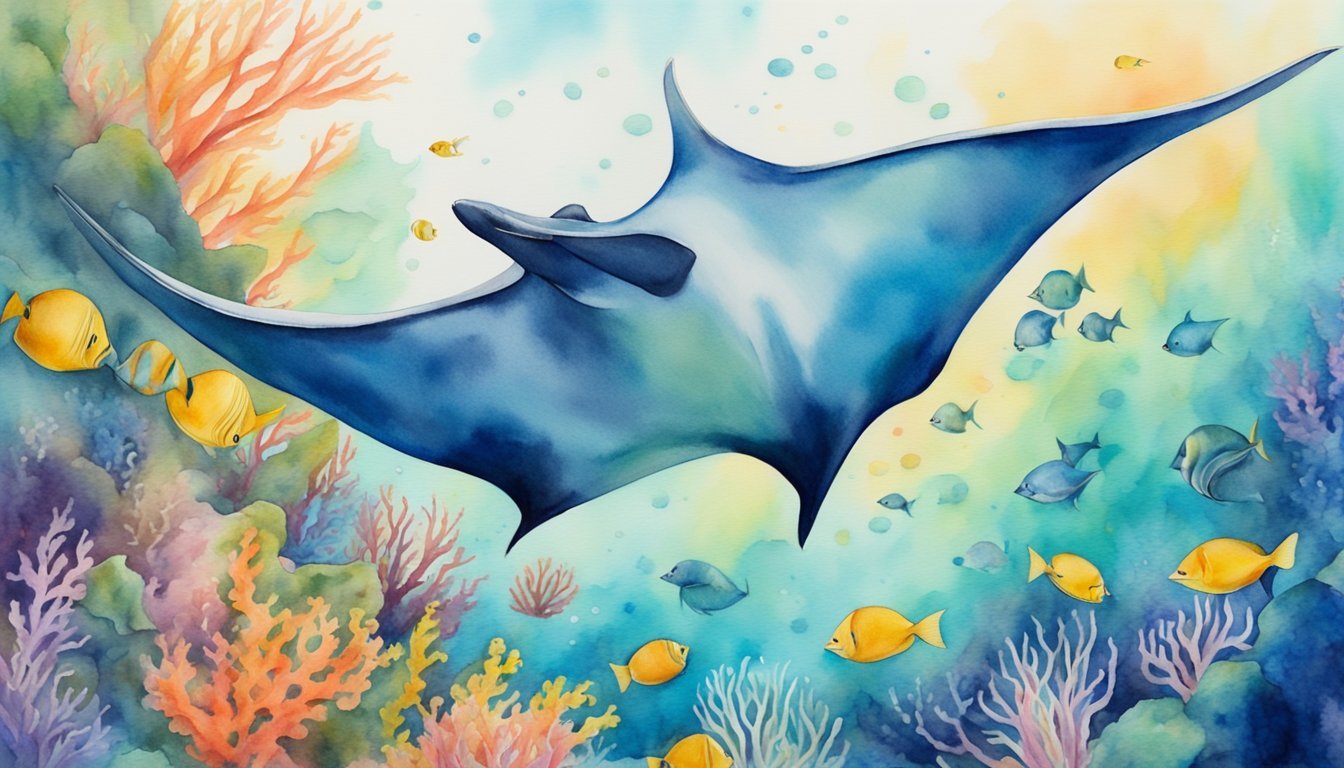Manta Ray Biology and Species
Manta rays are fascinating elasmobranchs, boasting significant sizes and unique biological features that set them apart from other marine species. Their biology and distinct species classification contribute to their intrigue and vulnerability in marine ecosystems.
Physical Characteristics
Manta rays are known for their large, diamond-shaped bodies, which are supported by triangular pectoral fins. These ‘wings’ allow them to glide through water effortlessly. They have a pair of unique, horn-shaped cephalic fins on their heads, which help channel food into their wide, forward-facing mouths. Adult manta rays can have a wingspan of up to 7 meters (23 feet) for the giant manta ray, and weigh as much as 1,350 kg (2,980 lbs). These animals are also known for their distinct white belly patterns, which are as unique as a fingerprint.
Species Distinction
Taxonomically, manta rays were previously categorized under their own genus but have since been reclassified within the genus Mobula. There are predominantly two species recognized: the larger giant oceanic manta ray (Mobula birostris) and the smaller reef manta ray (Mobula alfredi). They can be distinguished by their size, habitat preferences, and patterns on their back.
Habitat and Distribution
Manta rays are pelagic fish found in tropical and subtropical waters around the world, with the Indo-Pacific region being a common habitat. These species can also be found in the waters near Ecuador and prefer to stay within the epipelagic zone of the ocean, typically inhabiting areas with abundant plankton supply. They are known to congregate at cleaning stations and are frequently observed traveling alone or in small groups.
Diet and Feeding Habits
Manta rays are identified as filter feeders, consuming large quantities of zooplankton and small fish. To feed, they swim with their mouths open, using gill rakers to trap prey as water flows over their gills. Their diet plays a crucial role in maintaining their large size and energy needs.
Conservation and Interaction

Manta rays, intriguing and gentle giants of the ocean, face threats yet exhibit fascinating reproductive behaviors, and their interactions with humans can have both positive and negative impacts.
Ecological Threats
The conservation status of manta rays is of significant concern due to a range of ecological threats. Overfishing and bycatch in nets pose serious risks, especially to the reef manta ray and the giant manta ray. Sharks, often caught in the same fisheries, share these dangers. In some regions, manta rays are hunted for their meat, gill rakers, and other body parts, which are used in Chinese medicine. Pollution, in the form of microplastics and other debris, can lead to entanglement or ingestion, causing injury or death. Moreover, climate change impacts the distribution of their food sources, further threatening manta ray populations.
Reproductive Behavior
Manta rays have a low reproductive rate, with a lengthy gestation period that lasts over a year. The reproductive process involves intricate mating behaviors such as somersaults and close following. Rays give birth to live young, usually a single pup, which emphasizes the importance of protecting each individual for the sustainability of the species. Family Mobulidae, encompassing manta and devil rays, shares similar reproductive traits, making the conservation of these behaviors vital for the survival of these species.
Human Interactions
Human interactions with manta rays can have varying impacts, with tourism being a double-edged sword. On one hand, well-managed ecotourism can raise awareness and provide economic incentives for conservation. On the other, excessive or irresponsible tourism can disturb manta rays’ natural behaviors. Efforts in conservation range from establishing protected coastal areas where manta rays commonly congregate to international agreements restricting the trade of manta ray parts. Successful conservation often depends on the cooperation among local communities, governments, and international organizations in regulating fishing practices and protecting manta ray habitats.
- For details on manta rays’ unique body features and filter-feeding behavior, visit the NOAA Fisheries.
- To understand the full scope of the threats manta rays face, including overfishing and pollution, explore the Smithsonian Magazine article.
- To dive deeper into the reproductive behavior of manta rays, refer to The Manta Trust’s conservation program information.
- For a comprehensive view on the patterns of manta rays, check the study on association behaviors at PLOS ONE.

